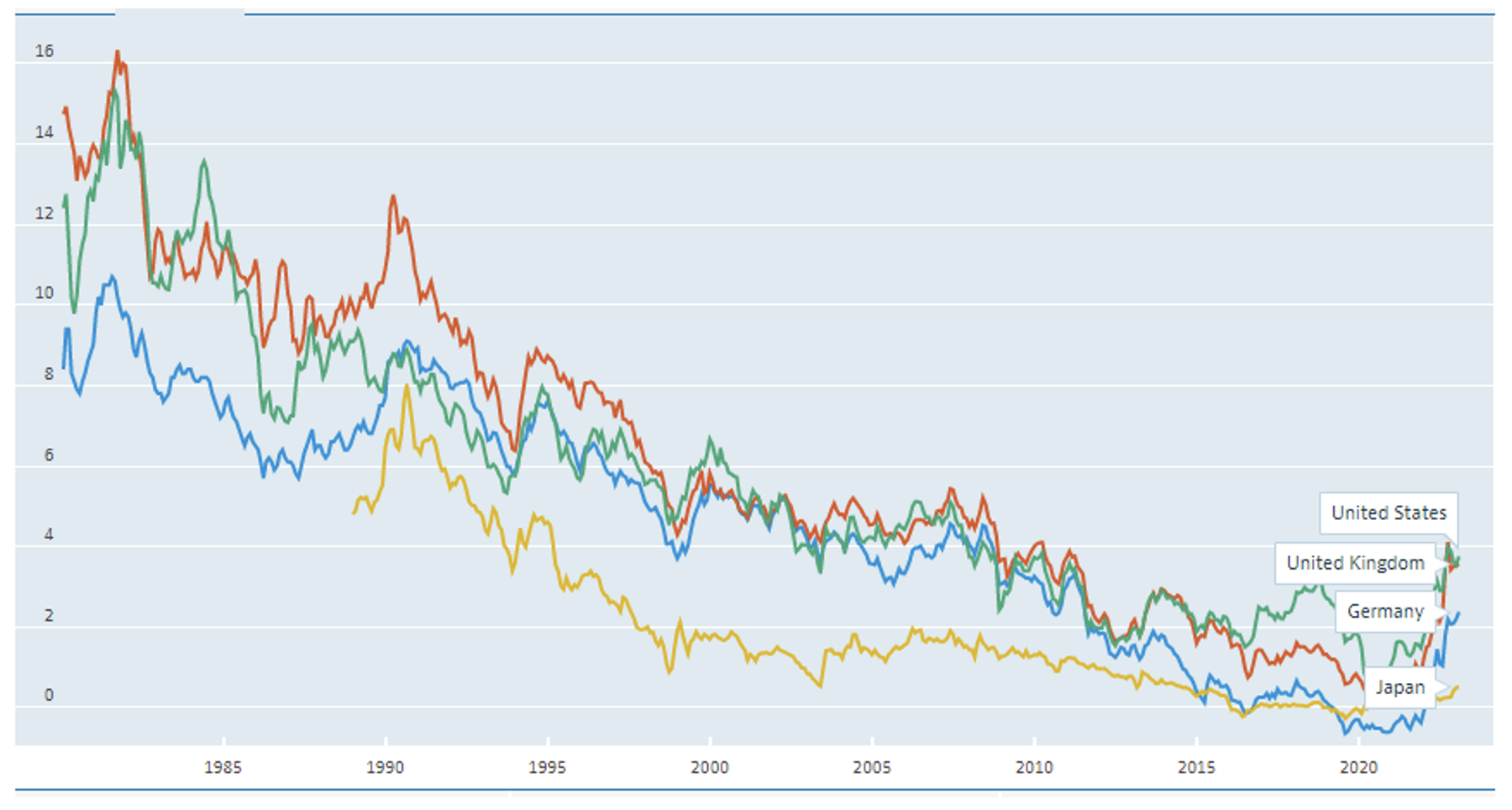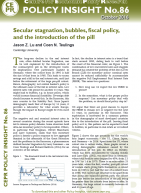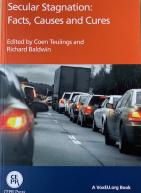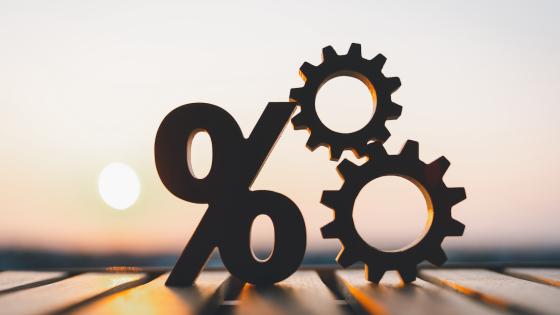The burst in inflation after Covid and the Ukrainian war has spurred a public controversy on macroeconomic policy. As Figure 1 shows, there has been a secular decline in nominal interest rates since 1980 (Teulings and Baldwin 2015). Did central banks keep rates too low for too long? Should they have raised them to a more natural level of 4%? Have low rates kept alive unsustainable business models? Did they cause high house prices and were they the harbingers of the current surge in inflation?
Figure 1 Secular decline in ten-year interest rate in four main monetary blocks since 1980
Note: Green: US, blue: Germany, red: UK, yellow: Japan.
Source: OECD
This debate is frequently framed in the classic controversy between Keynesianism and Monetarism of the 1970s. Keynesians claimed that fiscal policy played a crucial role in maintaining full employment. Instead, Milton Friedman proposed the concept of a natural rate of unemployment, determined by institutional factors like minimum wages, trade unions, and social security, rather than by fiscal policy. Trying to push unemployment below its natural rate by fiscal policy would merely raise inflation. His ideas became known as Monetarism. Robert Lucas extended Friedman’s ideas by adding rational expectations, showing that active fiscal policy would only destabilise expectations.
Friedman’s intervention came at a time when inflation and unemployment were still manageable. However, after the oil-price shocks of the 1970s, monetarists won the day: both inflation and unemployment surged. Central banks had to raise interest rates to bring inflation expectations back under control.
Currently, Keynesians are supposed to be the advocates of lax monetary policy, while Monetarists propagate a return to normality. The controversy between Keynesianism and Monetarism, however, is a counter-productive frame for the current debate. I propose an alternative classification, contrasting the Neoclassical view of the real interest rate as the price that clears the intertemporal market for consumption with the Neo-Austrian view that this market does not operate smoothly and that only keeping interest rates sufficiently high forces inefficient entrepreneurs to close down to free up resources for new endeavours. Where most (though not all) economists subscribe to the Neoclassical view, most of the financial press adheres to the Neo-Austrian school.
The new divide: Neoclassical versus Neo-Austrian
Our 1-0-1 class microeconomics teaches the standard Neoclassical model of Wicksell’s natural rate of interest as the price that clears the intertemporal market for consumption today versus tomorrow. Whether we embed it in a world of perfectly competitive markets or we allow for oligopolistic pricing, as in Dixit-Stiglitz, does not matter much. The interest rate is determined by supply and demand for future consumption – for example, an increase in life expectancy increases the demand for future consumption, which reduces the interest rate. This fall in the relative price of current consumption leads to intertemporal substitution from future to current consumption. Therefore, Wicksell’s natural rate is not some magically fixed number but the price that clears the intertemporal market.
In that same class, we teach the classical dichotomy between money and relative prices. In the absence of nominal contracts, doubling everybody’s money holdings doubles all prices but leaves relative prices unaffected. As long as we keep the distribution of money constant, the quantity of money is immaterial to real outcomes. We can extend this idea to a dynamic context, where everybody’s money holding is increased annually by some fixed percentage, say 2%. This raises all next year’s nominal prices by 2%, while the nominal interest rate – the real interest rate plus expected inflation – rises by 2 percentage points to keep the relative price of future consumption constant. The classical dichotomy holds, therefore, that the economy can operate at any level of predictable inflation. As Milton Friedman stated: inflation is always a monetary phenomenon.
So far for microeconomics. Macroeconomics emerges when we begin asking questions about where the money comes from. Money is a claim on future consumption. The more money an agent holds, the larger her claim on future consumption. Unpredictable inflation is, therefore, a bad thing for her since she cannot be sure about the real value of her claim. Last year, she planned to set apart sufficient money to buy a new car, but it turns out that she cannot afford it a year later since the car’s price has gone up unexpectedly. This makes unpredictable inflation costly.
This reasoning leads to standard Neoclassical macroeconomics. The efficient monetary policy makes inflation predictable. When the demand for current consumption unexpectedly exceeds its supply – current output – producers will respond by raising prices. This leads to unexpected inflation. According to the Taylor rule, central banks must respond by raising nominal interest rates. A higher interest rate reduces the relative price of future consumption, which leads to intertemporal substitution from current to future consumption. This restores equilibrium on the market for current output.
This argument ignores the role of investment. The investment provides an additional means for shifting consumption over time. By spending less on investment now, society shifts resources from future to current consumption. When there is excess demand for current consumption, lowering current investment helps therefore by means of a standard substitution effect from investment to consumption, induced by a higher interest rate.
This analysis helps to understand the secular decline in nominal interest rates since 1980. Central banks’ role in this decline must have been limited since expected inflation has been stable at a level somewhat below central bankers’ target of 2% until the recent outburst. The decline must therefore have been due to a fall in Wicksell’s natural rate. Central banks’ low nominal rates are, therefore, not a cause but a consequence of the fall in the natural rate. Any means of storing current production for future consumption is highly valuable in this situation. Since higher investment is an important means of shifting resources to future consumption, production has become more capital-intensive and the return to capital has fallen due to the declining marginal productivity of capital.
Consider what happens to the price of an asset with a cash flow that is somehow fixed till eternity (for example, a house generating a constant rental cash flow). Ignoring the role of risk for the moment, the price of this asset is its cash flow divided by Wicksell’s natural rate. Hence, asset prices will go up with a fall in the natural rate. Again, this is due not to central banks’ monetary policy but to the fall in the natural rate. When there is high demand for future consumption, the price of financial assets as stores of value increases since people want to hold claims on future consumption. Hence, rising asset prices are not a signal of excess demand for current output. Quite the contrary, they are a signal of excess demand for future output. Thus rising asset prices should not be included in the inflation statistic that central banks use for measuring the excess demand for current output as guidance for their monetary policy.
Although the details of the exact mechanism differ, this view is shared by a wide range of macro-economists, from John Cochrane (2022) of the University of Chicago to Olivier Blanchard (2019, 2023) and Paul Krugman. Both groups use essentially the same model, which is firmly grounded in standard microeconomic theory.
However, this view is not shared by all economists. Some seem to share a different cluster of viewpoints, which I refer to as the Neo-Austrian view. Their relevance is greatly enhanced by the fact that most of the financial press adheres to them, including many commentators of the Financial Times. It is somewhat difficult to do justice to them, as they tend to be less firmly based on standard microeconomics. Nevertheless, I make a try.
Neo-Austrians hold that the natural rate of interest is a fixed number, apparently about 4%. Central banks should lower interest rates below that natural rate during the downturn of the cycle to stimulate economic activity. They should increase interest rates in the upturn to cool down the economy. This view is clearly epitomised by the frequent observation in the financial press that “the past decade has been an episode of extremely lax monetary policy”. In the Neoclassical view, this statement does not make sense since central banks’ monetary policy aims to stabilise inflation expectations. If anything, these expectations have been below the 2% target, suggesting that central banks have set interest rates too high. In the Neo-Austrian view, to the contrary, this statement makes perfect sense since nominal interest rates have been far below the presumed natural rate of 4%.
The idea of a natural rate of 4% is embedded in the view that the market for corporate finance is heavily distorted. In the Neoclassical view, only those firms attract productive resources that generate the highest value added with these resources and can therefore offer the highest reward for them. In the Neo-Austrian view, to the contrary, the market mechanism cannot be trusted to yield an efficient allocation of resources. When interest rates are too low, inefficient firms can survive that would otherwise have been forced to close down since they can get funding at too low-interest rates. Central banks should increase interest rates not to stabilise inflation expectations, but to drive inefficient firms out. Where Neo-Austrians see inappropriately low central banks’ interest rates allowing inefficient business models to survive, Neoclassicals interpret the same phenomenon as efficient substitution towards more capital-intensive production in response to excess supply of capital, which drives down the Wicksell’s natural rate.
The paradox is that Neo-Austrians are the ultimate believers in the blessing of the free market. Nevertheless, they also hold that financial markets are a fragile infant that has been distorted by lax central banks’ monetary policy.
What explains the fall of Wicksell’s natural rate? Economists have come up with several explanations, of which I shortly discuss one: demography (Lu and Teulings 2016). Cohorts save during their working career to fund consumption during their retirement. A cohort’s pension savings reach a peak just before retirement. In such diverse countries as Japan, Germany, and China, the cohorts that are on the brink of retirement are currently exceptionally large. Their high retirement wealth leads to a savings glut causing Wicksell’s natural rate to decline.
Government’s fiscal policy has an effect on Wicksell’s natural rate, too. By running a larger sovereign debt, the government increases the demand for funding and hence the natural rate. Hence, monetary and fiscal policy have distinct roles. Monetary policy sets the nominal interest rates at a level that keeps inflation at its targeted level of 2%. If it is fully successful, the nominal interest rate is, therefore, equal to the real rate plus 2% inflation. Fiscal policy determines Wicksell’s natural rate by choosing a debt target. The higher the debt, the higher the public demand for funding and hence Wicksell’s natural rate. The low-interest rates in the euro area in the past decade, see Figure 1, therefore, suggest that euro area countries have run too low a sovereign debt to absorb the supply of savings.
Public debt and the risk premium
Since agents are risk averse, they prefer to hold safe assets with a fixed return above assets with a risky return. However, actual investment is always risky. When all investment is risky, how can there be safe assets? For every risk-free claim on future consumption, there must be another party holding the obligation to guarantee the supply of this consumption. Which party can shoulder these obligations? Only the government, since when the water flows over the dykes and the government can no longer roll over its debt by issuing new bonds, can always revert to taxing future generations.
The rules of double-entry accounting imply that the sum of safe claims and obligations must be equal. Stated differently, the sum of all deposits must equal the sum of all debts. On balance, the private sector wants to hold safe assets: a safe net claim on future consumption. Then, inevitably, the public sector must hold a net debt of equal size. The financial press and even renowned institutions like the IMF frequently make claims like: “There is too much debt in the world. Both the public and the private sector should lower their debts and should hold more buffers to absorb shocks.” This statement is inconsistent: since the net debt of the public sector is equal to the net buffers of the private sector, you cannot simultaneously reduce one and increase the other.
This analysis offers insight into the role of public debt: it supplies safe assets to the private sector. It shifts risk from current to future generations. The government acts as an insurance company. It sells risk-free claims to current generations, but charges an insurance premium for this activity to the benefit of future generations: the risk premium. The risk for future generations is that in case the government has to pay a higher interest rate when rolling over its debt, future generations will have to shoulder this higher interest burden. Their reward for this risk is the risk premium. Holding public debt is, therefore, a trade-off between the risk premium on the one hand and the risk of a future increase in interest rates on the other.
Author’s note: This column is an excerpt from a longer paper (Teulings 2023) that deals with wider set of questions regarding: (i) the r – g conundrum, (ii) the validity of the quantity theory of money, (iii) the term structure of interest rate and QE, (iv) Reiss’ (2022) critique on central banks’ monetary policy, (v) the problem of monetary-without-fiscal union, and (vi) and the future value of r – g, and vii) the optimal level of the inflation target of 2%.
References
Blanchard, O (2019), “Public debt and low interest rates”, American Economic Review: 1197-1229.
Blanchard, O (2023), Fiscal policy under low interest rates, MIT press.
Caballero, R and E Farhi (2018), “The safety trap”, The Review of Economic Studies 85(1): 223-274.
Cochrane, J H (2022), “Expectations and the Neutrality of Interest Rates”, NBER Working Paper 30468.
Lu, J and C Teulings (2016), “Falling real interest rates, house prices, and the introduction of the pill”, CEPR Policy Insight 86.
Reis, R (2022), “The Burst of High Inflation in 2021-22: How and Why Did We Get Here?”, CEPR Discussion Paper 17514.
Teulings (2023), “The distinction between Keynesians and Monetarists makes no sense anymore”, SSRN paper 4450095.
Teulings, C and R Baldwin (2014), Secular stagnation: facts, causes and cures, CEPR Press.




